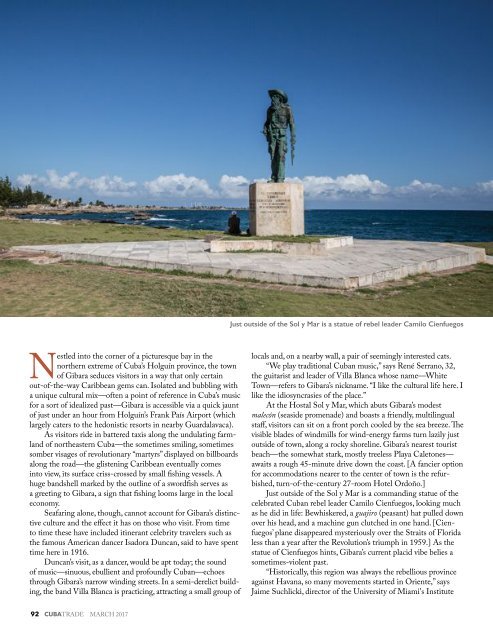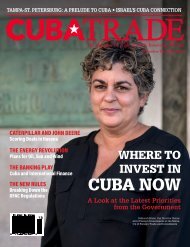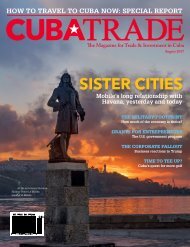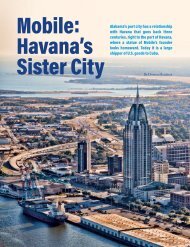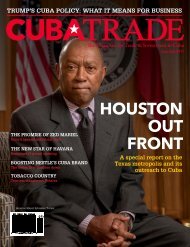You also want an ePaper? Increase the reach of your titles
YUMPU automatically turns print PDFs into web optimized ePapers that Google loves.
Just outside of the Sol y Mar is a statue of rebel leader Camilo Cienfuegos<br />
Nestled into the corner of a picturesque bay in the<br />
northern extreme of Cuba’s Holguín province, the town<br />
of Gibara seduces visitors in a way that only certain<br />
out-of-the-way Caribbean gems can. Isolated and bubbling with<br />
a unique cultural mix—often a point of reference in Cuba’s music<br />
for a sort of idealized past—Gibara is accessible via a quick jaunt<br />
of just under an hour from Holguín’s Frank País Airport (which<br />
largely caters to the hedonistic resorts in nearby Guardalavaca).<br />
As visitors ride in battered taxis along the undulating farmland<br />
of northeastern Cuba—the sometimes smiling, sometimes<br />
somber visages of revolutionary “martyrs” displayed on billboards<br />
along the road—the glistening Caribbean eventually comes<br />
into view, its surface criss-crossed by small fishing vessels. A<br />
huge bandshell marked by the outline of a swordfish serves as<br />
a greeting to Gibara, a sign that fishing looms large in the local<br />
economy.<br />
Seafaring alone, though, cannot account for Gibara’s distinctive<br />
culture and the effect it has on those who visit. From time<br />
to time these have included itinerant celebrity travelers such as<br />
the famous American dancer Isadora Duncan, said to have spent<br />
time here in 1916.<br />
Duncan’s visit, as a dancer, would be apt today; the sound<br />
of music—sinuous, ebullient and profoundly Cuban—echoes<br />
through Gibara’s narrow winding streets. In a semi-derelict building,<br />
the band Villa Blanca is practicing, attracting a small group of<br />
locals and, on a nearby wall, a pair of seemingly interested cats.<br />
“We play traditional Cuban music,” says René Serrano, 32,<br />
the guitarist and leader of Villa Blanca whose name—White<br />
Town—refers to Gibara’s nickname. “I like the cultural life here. I<br />
like the idiosyncrasies of the place.”<br />
At the Hostal Sol y Mar, which abuts Gibara’s modest<br />
malecón (seaside promenade) and boasts a friendly, multilingual<br />
staff, visitors can sit on a front porch cooled by the sea breeze. The<br />
visible blades of windmills for wind-energy farms turn lazily just<br />
outside of town, along a rocky shoreline. Gibara’s nearest tourist<br />
beach—the somewhat stark, mostly treeless Playa Caletones—<br />
awaits a rough 45-minute drive down the coast. [A fancier option<br />
for accommodations nearer to the center of town is the refurbished,<br />
turn-of-the-century 27-room Hotel Ordoño.]<br />
Just outside of the Sol y Mar is a commanding statue of the<br />
celebrated Cuban rebel leader Camilo Cienfuegos, looking much<br />
as he did in life: Bewhiskered, a guajiro (peasant) hat pulled down<br />
over his head, and a machine gun clutched in one hand. [Cienfuegos’<br />
plane disappeared mysteriously over the Straits of Florida<br />
less than a year after the Revolution’s triumph in 1959.] As the<br />
statue of Cienfuegos hints, Gibara’s current placid vibe belies a<br />
sometimes-violent past.<br />
“Historically, this region was always the rebellious province<br />
against Havana, so many movements started in Oriente,” says<br />
Jaime Suchlicki, director of the University of Miami's Institute<br />
92 CUBATRADE MARCH 2017


